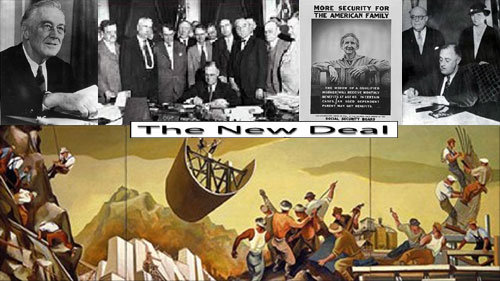|

In
a utopian world, everyone would have all
they need for life, liberty and the pursuit
of happiness, and at least the chance
to achieve their hearts’ desires. In order
to create that reality, the institutions
and the infrastructures that control our
daily lives must have this mission and
purpose at the core of their foundation,
and must function to help, or at least
not hinder, the inclusion of every member
of society to enjoy these basic rights.
In October, 1929, the Wall Street Stock
Market crashed, plunging the United States
into the worst economic Depression in
history. The widespread devastation and
suffering this caused, illustrated the
failure and lack of utopian mission in
the dominant institutions of the day;
clearly the governmental infrastructure
and the economic institutions had not
been acting in the best interests of the
majority of the people. The nation was
in desperate need of change, and it came
through the economic policies of Franklin
Delano Roosevelt’s “New Deal.”
Between
1933 and 1938, presidential executive
orders and laws adopted by Congress focused
on The New Deal’s ‘3 Rs’ – Relief
for the unemployed, Recovery
of the economy, and Reform
of the financial institutions and policies
that caused the problems in the first
place. The government provided assistance
to help many of the nation’s industries
get back on their feet – the banks, railroads,
automobile manufacturers and farms, for
example. The Works Progress Administration
put millions of unemployed Americans to
work, building roads, bridges, hospitals,
schools, irrigation systems, reservoirs,
parks and playgrounds, making the federal
government the nation’s largest employer.
The Social Security Act was passed to
provide a basic economic safety net for
the nation’s elderly, and institutions,
like the United States Housing Authority
to abolish slums in the cities, and Farm
Security Administration to combat rural
poverty, were established to help the
poor. Laws were passed to ensure continuing
economic justice for all, like the Fair
Labor Standards Act of 1938, which set
minimum wages and maximum work hours for
workers. Labor Unions were promoted and
banking and other financial regulations
were enacted to prevent the greedy practices
that had caused the Depression.
Not
everyone agreed on the policies of The
New Deal, however. As the nation recovered,
the divide grew and by 1938, ‘conservatives’
– those who were against the policies
of The New Deal, began to have more influence
in Congress than the ‘liberals’ – those
who supported The New Deal. By the early
1940s, many of the relief programs were
shut down and most of the new liberal
proposals were blocked. President Dwight
Eisenhower, the first Republican President
after Roosevelt, retained most of the
New Deal institutions and infrastructure
that remained during his presidency from
1953-1961. President Lyndon Johnson greatly
expanded many of The New Deal’s liberal
ideas in his Great Society policies in
the 1960s, and Republican President Richard
Nixon left them largely intact. In the
1970s, however, deregulation gained widespread
support, and many of the safeguards and
regulations of The New Deal began to be
dismantled.
Today,
the divide created by the ideas of the
New Deal continues, and illustrates a
general difference in worldview between
conservatives and liberals: conservative
views are informed by a sense of individualism
and reliance on family and community instead
of government; liberals see the ‘social
contract’ as a basic foundation for society
– if citizens are asked to obey the laws
imposed by a society, society is obligated
to provide for the basic needs of all
of its citizens. The battle over the ideals
of The New Deal rages with new intensity
today as each side sees conflicting solutions
to the social and economic woes of our
times.
|